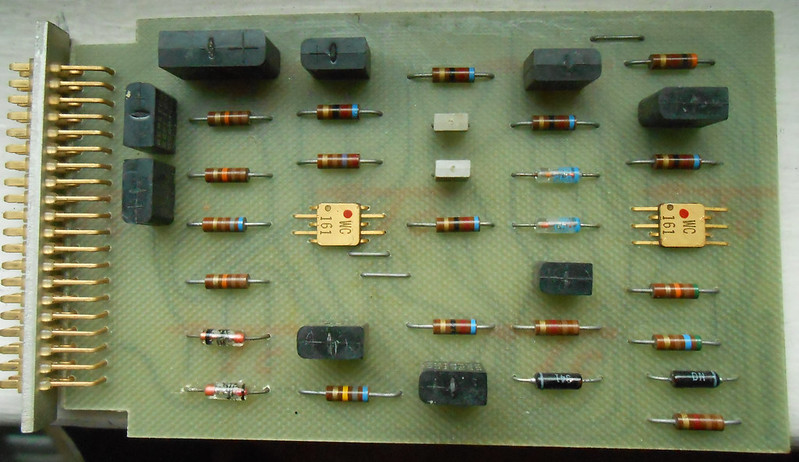Got this little guy recently with a couple old flatpack ICs, and have been trying to figure out what it is:


There's not much identifying info on the ICs, just "WC 161", and I don't know enough to connect that to anything specific:

I'm not at all a vintage computing expert, but from taking a quick look through some photos, the connector/form factor/lack of handle doesn't really match anything obvious. The only thing I saw with a similar connector is
an early Univac military aircraft computer, but doesn't match that or other Univac systems in any way, as far as I can tell.
The same eBay seller has more boards that look similar to this one:
https://www.ebay.com/itm/126231708839...plus a whole batch of others that look like they're from the same system, and use Fairchild DTµL DTL logic chips, just like the
Honeywell 316 (but I can't find a link right now because I think they got sold?). See attached image at the end.
Using DTL logic suggests that, like the Honeywell 316, it wasn't part of some top-of-the-line pushing-performance-boundaries computer, but instead something meant to be more on the cheap (and maybe reliable) side.
Anyways, the far more interesting part is: what exactly does this card do? Because of the small number of parts, the low density, and the single-sided routing, this one was supremely easy to trace the circuitry: didn't even have to do the normal "take photos from each side and overlay them" trick.

My best guess is that this is a 2-stage amplifier for pulses (judging by the AC-coupled input), for something like a readout from a ferrite core memory array, where a low-amplitude pulse is amplified until it's clipped, and drives a digital output (open-collector, with pull-up). The "WC 161" chip probably has a couple cascaded differential pairs of transistors, probably a PNP diff-pair driving an NPN-diff pair (collectors directly connected to the output pins), judging by the external connections. I'm not confident in this interpretation, and I'm not even 100% sure that the direction of signal flow here is correct, but this is the only way that the schematic fully makes sense to me.
It's interesting to see how the same chip is used in different ways in the 2 different stages, with sets of pins that aren't used in each case. I think the first stage might be used as a linear amplifier, considering what looks like a DC-biasing feedback path plus some compensation components to stabilize the amplifier, while the second stage is driven to max. gain and used as a comparator (and therefore also doesn't need any compensation).
I'm not sure where pins 9 and 10 connect internally, but it seems to be using a zener-regulated voltage below the analog supply (maybe 5V) to clamp or bias some internal points, maybe as an amplitude limiter, or to keep the internal transistors from saturating when used in this non-linear-comparator-mode to avoid slowing down their turn-off times.
The digital output also gets a pull-up resistor to its own (likely-identical-5V) zener-regulated voltage.
Let me know if you have any better guesses or think I'm wrong about something.